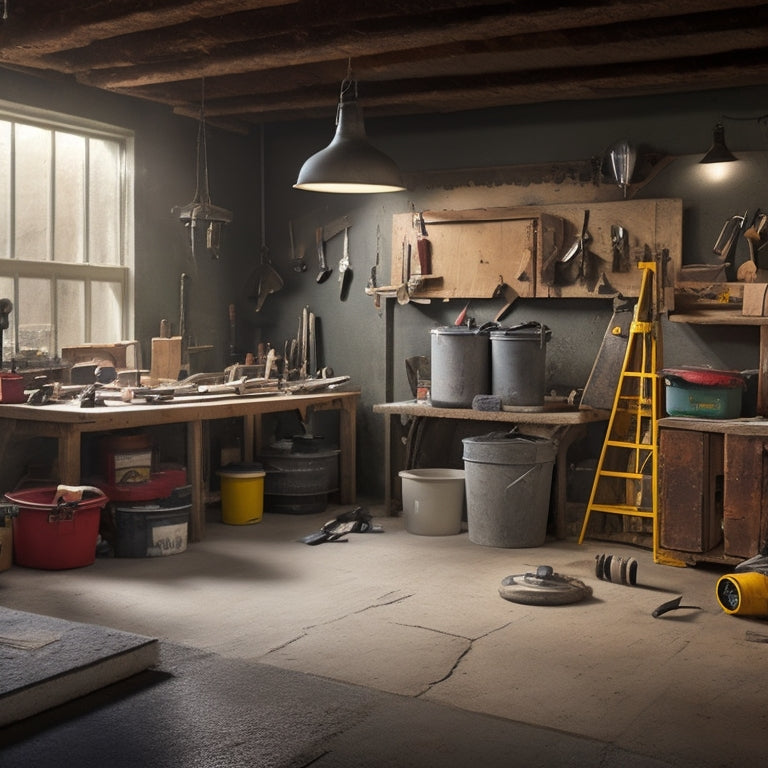
Selecting the Right Tools for Concrete Flooring Installation
Share
You need the right tools to guarantee a successful concrete flooring installation, and selecting them starts with understanding the specific demands of your project and the unique requirements of concrete flooring. Your essential toolkit should include a spirit level, laser level, notched trowel, grout float, and tile cutter or nippers. You'll also need a rubber mallet, chisel set, and spacers to guarantee consistent joint widths. Additionally, consider investing in tile saws, drill bits, and safety equipment for precise cuts. By choosing the right tools, you'll be well on your way to a professional-looking installation; now, take the next step to optimizing your workflow and achieving flawless results.
Key Takeaways
- Choose the right notched trowel size and material based on concrete mix design, trowel techniques, and desired finish.
- Select suitable adhesive and grout application tools, such as spirit levels, laser levels, and grout floats, for accurate and efficient installation.
- Invest in high-quality tile cutting and drilling tools, including tile saws, drill bits, and safety equipment, for precise cuts and minimal damage.
- Ensure proper surface preparation, adhesive mixing, and application techniques to achieve strong bonds and uniform color.
- Use specialized tools for lippage control, surface leveling, edging, and profiling to achieve a perfectly level and visually appealing concrete floor.
Essential Tile Setter Tools
At least a dozen crucial tools are necessary for a tile setter to complete a concrete flooring installation successfully.
You'll need a range of tools to guarantee precise tile layout techniques and thorough surface preparation. A spirit level, for instance, helps you achieve accurate vertical and horizontal alignments, while a laser level assures straight lines and perfect squares.
A notched trowel is essential for applying adhesive, and a grout float helps you fill gaps between tiles. Don't forget a rubber mallet for tapping tiles into place and a tile cutter or tile nippers for cutting tiles to fit around obstacles.
Surface preparation tips dictate the use of a scraper or grinder to remove old adhesive, dirt, or oil from the concrete surface. You'll also need a vacuum cleaner to remove dust and debris.
With these crucial tools at your disposal, you'll be well-equipped to tackle even the most complex concrete flooring installation projects.
Hand Tool Kits for Tile Installation
Your hand tool kit for tile installation should be a well-curated assembly of essentials that streamline your workflow and guarantee precision.
A complete kit enables you to efficiently complete tasks, assuring a high-quality finish and minimizing the risk of errors.
To make certain your kit covers all bases, include the following:
- Tile nippers and cutters: for precise cutting and shaping of tiles to fit around obstructions or into tight spaces.
- Grout float and grout sponge: for efficient grout application and smoothing, assuring a professional finish.
- Tile scraper and edger: for thorough tile surface preparation, removing old adhesive or debris, and creating a smooth surface for new tile installation.
A thoughtful hand tool kit selection also considers grout color selection, as the right shade can vastly impact the overall aesthetic of your concrete flooring installation.
Notched Trowel Selection Guide
When selecting a notched trowel, you'll want to take into account the size of the trowel, as it directly impacts the coverage area and material distribution.
The type of notched edge is also essential, as it affects the finish and texture of the concrete floor.
Trowel Size Matters
Selecting the right notched trowel size is essential for achieving a smooth, even finish in concrete flooring installation. You want to verify that the trowel you choose can effectively hold and spread the concrete, allowing you to achieve the desired finish.
When selecting a notched trowel, consider the following factors:
-
Concrete mix design: Thicker mixes require larger notches to hold and spread the material, while thinner mixes require smaller notches.
-
Trowel techniques: Your personal technique and style of spreading the concrete will influence the size of the notches you need.
-
Trowel materials: The type of material used to make the trowel, such as stainless steel or aluminum, can affect its size and durability.
Notched Edge Types
As you've considered the factors influencing your notched trowel size, it's time to examine the notched edge types that will further refine your concrete flooring installation. Notched edge types are designed to optimize the notched trowel benefits, guaranteeing a smooth, even finish.
You'll find three primary notched edge types: round, square, and V-shaped. Round-edged notches are ideal for creating a smooth, rounded finish, while square-edged notches provide a more aggressive texture. V-shaped notches, with their sharp, angled edges, are perfect for creating a textured, slip-resistant surface.
When selecting a notched edge type, consider the specific requirements of your concrete flooring installation. Think about the type of concrete, the desired finish, and the level of texture needed.
Notched trowel materials also play a significant role, as they can impact the durability and performance of your tool. Choose notched trowels made from high-quality materials, such as stainless steel or aluminum, to guarantee a long-lasting and reliable tool.
Grout Float and Grout Pump
Your concrete flooring installation toolkit isn't complete without a grout float and grout pump, two vital tools that assure a smooth, even grout application.
These tools work in tandem to guarantee professional-looking results and a long-lasting floor.
When using a grout float, master these techniques:
- Hold the float at a 45-degree angle to the floor to effectively press grout into the gaps.
- Use a gentle, sweeping motion to spread the grout evenly.
- Apply moderate pressure to remove excess grout and achieve a smooth finish.
In addition to proper grout float techniques, it's essential to maintain your grout pump regularly.
This includes cleaning the pump after each use, lubricating moving parts, and storing it in a dry, protected area.
Proper grout pump maintenance assures consistent performance and extends the tool's lifespan.
Rubber Mallet and Chisel Set
With a smooth grout application under your belt, it's time to move on to the next crucial step in concrete flooring installation: preparing the surface for finishing. This is where a rubber mallet and chisel set come into play.
You'll use these tools to remove any excess grout, old adhesive, or other debris that might be stuck to the surface. A rubber mallet offers several benefits, including reducing the risk of damaging the concrete and providing a more controlled impact.
When it comes to chisel techniques, you'll want to use a gentle, glancing blow to avoid scratching the surface. Hold the chisel at a 20- to 30-degree angle and work in small sections to maintain even pressure.
Spacers and Lippage Control
You'll need to guarantee proper spacer placement to achieve consistent joint widths and prevent lippage, which can lead to uneven flooring.
To do so, you'll want to familiarize yourself with lippage control methods, including the use of specialized tools and techniques.
Proper Spacer Placement
Properly positioning spacers is crucial in achieving a successful concrete flooring installation, as it directly impacts the overall aesthetic and durability of the finished product.
When you get it right, you'll achieve a beautiful, long-lasting floor that meets your expectations.
To get started, you need to choose the right spacer types for your project. There are different types, each designed for specific installation techniques. Here are three key considerations to keep in mind:
-
Spacer size: Verify the spacers you choose are the right size for your tile or slab. Incorrect sizes can lead to uneven joints, which compromise the floor's appearance and durability.
-
Spacer material: Select spacers made from materials that can withstand the weight and traffic of your floor. For example, plastic or metal spacers are suitable for high-traffic areas, while foam spacers are better for residential projects.
-
Spacer placement: Properly position spacers to maintain even joints and prevent lippage. You can use a combination of spacers and wedges to achieve perfectly aligned joints.
Lippage Control Methods
Lippage control is a critical aspect of concrete flooring installation, as it directly affects the final appearance and performance of the floor. To achieve a smooth, even surface, you'll need to employ effective lippage prevention techniques.
One essential tool in your arsenal is spacers, which help maintain consistent joint widths and prevent lippage. You'll also need surface leveling tools, such as a spirit level or laser level, to guarantee the floor is perfectly level. By combining these tools with proper spacer placement, you can achieve a floor that's both visually appealing and functional.
When selecting lippage control methods, consider the specific requirements of your project. For example, if you're working with large format tiles, you may need to use specialized spacers designed for these types of installations.
Additionally, be certain to follow the manufacturer's instructions for spacer placement and surface leveling to achieve the best results. By taking a proactive approach to lippage control, you can avoid costly mistakes and guarantee a successful concrete flooring installation that meets your high standards.
Tile Cutting and Drilling Tools
When installing concrete flooring, precise cuts and drilled holes are essential for a professional-looking finish. To achieve this, you'll need the right tile cutting and drilling tools.
-
Tile Saws: A tile saw is a must-have for making precise cuts in concrete tiles. There are two types: wet saws and dry saws. Wet saws use a water-cooled blade to reduce dust and heat buildup, while dry saws are more portable and convenient. Choose the one that best fits your project needs.
-
Drill Bits: Drill bits are used to create holes for anchors, screws, or other fasteners. You'll need drill bits specifically designed for concrete, such as carbide-tipped or diamond-coated bits. These can withstand the hardness of concrete and provide a clean, precise hole.
-
Cutting Techniques and Safety Equipment: Developing proper cutting techniques is vital to avoid damaging the tile or injuring yourself. Always wear safety equipment, including gloves, safety glasses, and a dust mask, to protect yourself from flying debris and dust.
Practice cutting techniques, such as scoring and snapping, to achieve clean, precise cuts.
Edging and Profiling Tools
You've made precise cuts and drilled holes in your concrete tiles, now it's time to focus on creating clean edges and profiles. Edging techniques are essential to achieving a professional finish, and the right tools can make all the difference.
For a smooth, rounded edge, you'll need a concrete edger, which comes in various sizes and types. Carbide-tipped edgers provide a high-quality finish, while diamond-edged tools are ideal for more aggressive profiling.
When it comes to profiling methods, you'll need to choose the right tool for the specific job. A concrete profiler, for instance, is perfect for creating decorative profiles, such as chamfers or bevels. These tools typically feature interchangeable profiling wheels that can be customized to suit your design preferences.
Additionally, consider investing in a dustless edging system, which helps minimize mess and maximizes efficiency. By selecting the right edging and profiling tools for your concrete flooring installation, you'll be able to achieve a high-quality finish that meets your design vision.
Mixing and Applying Adhesives
You'll need to select the right adhesive type for your concrete flooring installation, considering factors like substrate, traffic, and environmental conditions.
Next, you'll want to excel in proper mixing techniques to guarantee a consistent, strong bond, following the manufacturer's instructions and factoring in variables like temperature and humidity.
Adhesive Type Selection
Your concrete flooring installation project's success relies heavily on the adhesive type you select, as it directly impacts the floor's durability and aesthetic appeal.
With so many options available, it's crucial to choose an adhesive that meets your specific needs and guarantees a strong bond between the concrete and the flooring material.
When selecting an adhesive, consider the following factors:
-
Adhesive performance: Look for adhesives with high bonding strength, flexibility, and resistance to moisture and extreme temperatures.
-
Environmental considerations: Opt for eco-friendly adhesives with low VOCs (volatile organic compounds) or those made from sustainable materials to minimize your project's environmental footprint.
-
Substrate compatibility: Verify the adhesive is compatible with the specific concrete substrate and flooring material you're working with to prevent failures and guarantee a long-lasting bond.
Proper Mixing Techniques
Since the adhesive type has been selected, attention must now turn to proper mixing techniques to guarantee a strong, durable bond between the concrete and flooring material.
You'll need to follow the manufacturer's instructions for mixing ratios, as these can vary depending on the specific adhesive and flooring material used. Typically, the mixing ratio is specified as a proportion of adhesive to hardener, and it's essential to get this right to achieve the desired bond strength.
Invest in high-quality mixing equipment, such as a mixing bucket and drill with a mixing paddle, to assure thorough and consistent mixing.
Start by adding the recommended amount of hardener to the mixing bucket, followed by the adhesive. Mix the components together in a circular motion, working from the center of the bucket outwards. Continue mixing until the adhesive reaches a uniform color and consistency, usually within 2-3 minutes.
Be sure to scrape the sides and bottom of the bucket to prevent unmixed material from affecting the bond. By following these mixing techniques, you'll be able to achieve a strong, reliable bond between the concrete and flooring material.
Application Best Practices
With a strong, reliable bond between the concrete and flooring material assured through proper mixing techniques, attention now shifts to application best practices for mixing and applying adhesives.
You'll want to guarantee a successful installation by following these guidelines.
When it comes to application, you'll need to focus on three key areas:
-
Surface preparation techniques: Confirm the concrete substrate is clean, dry, and free of contaminants. This may involve mechanical preparation methods like grinding or shot blasting to achieve the ideal surface profile.
-
Moisture management strategies: Assess the concrete's moisture levels and apply a suitable moisture barrier or epoxy-based adhesive to prevent adhesive failure.
-
Adhesive application: Follow the manufacturer's instructions for application rates, temperature, and humidity. Use a notched trowel to apply the adhesive, holding it at a 45-degree angle to guarantee even coverage.
Cleaning and Sealing Tools
Concrete flooring installation requires a carefully clean surface to guarantee a strong bond between the concrete and sealant. You'll need the right cleaning and sealing tools to achieve this.
When it comes to cleaning techniques, you'll want to use a combination of mechanical and chemical methods. A concrete floor scrubber or grinder can effectively remove dirt, oil, and old coatings, while a degreaser or acid etcher can deep clean and prepare the surface for sealing.
For sealing methods, you'll need a high-quality sealant and the right application tools. A lambswool applicator or microfiber mop is ideal for applying sealants evenly and efficiently. You may also need a sealant sprayer or roller extension pole for larger areas.
Don't forget to choose the right sealant for your specific flooring needs, whether it's an acrylic, epoxy, or polyurethane-based product. With the right cleaning and sealing tools, you'll be able to achieve a strong, durable bond between the concrete and sealant, ensuring a long-lasting and high-performance flooring system.
Frequently Asked Questions
Can I Use a Hammer Instead of a Rubber Mallet for Tile Installation?
When it comes to tile installation techniques, you're wondering if you can swap a hammer for a rubber mallet, but don't - the impact tool comparison is clear: hammers can crack tiles, while mallets provide a gentler, more controlled tap.
How Do I Prevent Grout Haze From Forming on Newly Installed Tiles?
You'll prevent grout haze by immediately cleaning excess grout with a damp sponge, then using a grout removal product and scrub brush to remove residue, followed by a thorough tile cleaning with a neutral cleaner and water.
What Is the Ideal Temperature for Installing Concrete Flooring?
You've heard the theory that ideal installation temperatures for concrete flooring are between 50°F and 90°F, and you're right! Research confirms that temperatures outside this range can affect curing, so you'll want to guarantee your installation conditions are just right.
Can I Install Concrete Flooring Over Existing Hardwood Floors?
You're wondering if you can install concrete flooring over existing hardwood floors. Yes, you can, but weigh the pros and cons: added weight, potential moisture issues, and increased installation complexity versus a unique, industrial look and added durability.
Do I Need to Seal Concrete Flooring in High-Traffic Commercial Areas?
Ha! You think you can just slap down concrete and call it a day? Think again, friend! In high-traffic commercial areas, you'd better seal that concrete to guarantee traffic durability and reap sealing benefits - or kiss your investment goodbye!
Conclusion
You've made it to the final stage of selecting the right tools for your concrete flooring installation. Now, you're equipped with the knowledge to tackle any tile installation project that comes your way. But, can you imagine starting a project without the right tools? It's like trying to build a house without a foundation - it's bound to crumble. With the essential tools in your arsenal, you're ready to create a concrete flooring work of art that will last for years to come.
Related Posts
-

Why You Need Affordable Concrete Wall Construction Tools
You need affordable concrete wall construction tools to guarantee a profitable project, as the cost of equipment can ...
-

5 Best Tools for Stamping Concrete Walls
When it comes to stamping concrete walls, you'll need a range of specialized tools to achieve the desired texture and...
-

Why These Concrete Tools Are Always in Demand
You rely on a set of trusted concrete tools to deliver high-quality results, and it's not surprising - these tools ar...


